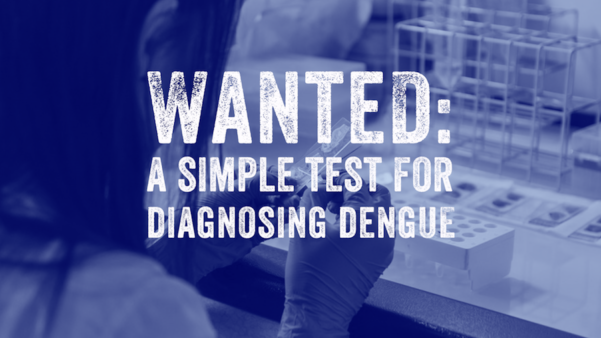- by Gary Finnegan
Wanted: a simple test for diagnosing dengue

Diagnosing dengue has become a major research focus follow calls from the WHO for point-of-care testing to be used prior to dengue vaccination.
The World Health Organisation’s Strategic Advisory Group of Experts (SAGE) on immunization has proposed that people be tested to see if they have had dengue in the past before they are given the dengue vaccine.
At its April 2018 meeting, SAGE noted second infections with a dengue virus can be worse than first infections, and that the best candidates for vaccination are those who have had a previous infection. The group suggests that the vaccine is of most value to public health, and least risk to individuals, in countries where dengue fever is endemic.
The call for a simple point-of-care test has injected new urgency into research on tools for diagnosing dengue that is rapid, inexpensive, accurate and mass produced. Today, such a test does not exist. Several are in development but some estimates suggest it could be two to three years before a suitable product hits the market.
At present, there is no straightforward way of diagnosing dengue. Lab-based tests are slow and mobile diagnostic kits are not yet accurate enough to determine whether patients have had dengue.
Tests that reveal whether a patient has a dengue virus now are no use: what’s needed is a simple pin-prick blood testing kit capable of diagnosing dengue in a matter of minutes. Patients requesting vaccination could then await the results and, depending on the outcome, have the first of their dengue vaccines.
Where are we now?
The London School of Hygiene and Tropical Medicine published a detailed report last year on the dengue diagnostics landscape. It highlights the major drawbacks with currently-available options, ranging from complexity and cost to speed and accuracy.
One of the most promising technologies comes from BluSense diagnostics – a start-up featured on Break Dengue in 2015 and 2016. They have used Blu-Ray technology to develop a portable diagnostic kit that quickly and accurately detects one of the biomarkers for dengue fever (NS1) based on a simple pinprick of blood.
According to Dr. Marco Donolato, formerly researcher at the Technical University of Denmark and now Chief Scientific Officer at BluSense Diagnostics, and one of the authors of the Nature Scientific Reports paper on diagnosing dengue says the technology is a ‘cheap and easy to use system, as simple to manipulate as a standard Blu-ray disc player.’
Since the publication of the 2015 paper, the company has attracted strong interest from the research community and funding agencies. BlueSense won the Malaysian Colussus Inno 2017 for entrepreneurship in a competitive field of more than 1,800 projects worldwide.
Diagnosing dengue and the race against time
The company plans to begin a feasibility project in Kuala Lumpur in July. This community study will be used to evaluate BluSense technology in diagnosing past dengue infections among 500 people of different age groups, mostly children.
‘We expect to have initial results by October this year,’ says company founder and CEO Filippo Bosco. ‘If the study goes well, we shall have a product ready for on-field validation early in 2019.’
The road from a high-tech idea to clinics in dengue-endemic countries is long but BluSense has been quietly working away for years – long before the WHO SAGE committee statement relating to dengue vaccination. While others will now invest in the field, BluSense appears as likely as any to reach the market next year.
‘Our goals are to have a point-of-care test that, in less than 10 minutes, will give a clear answer on the vaccinability of a person,’ Bosco told Break Dengue. ‘This would not require phlebotomy [drawing of blood using a syringe] but will be done via a single capillary finger prick requiring only 10 uL of blood. The current status of the technology is very promising, but we won’t have any final feasibility data before after the summer.’
Gene editing tech
There are other high-tech solutions in the pipeline that could ultimately make diagnosing dengue quick and easy. A ground-breaking gene-editing technology – known as CRISPR – has sparked a biotech revolution that is expected to translate into dozens of new gene therapies over the coming decade.
However, fixing faulty genes is not its only applications. Companies such as Mammoth Biosciences are looking at the power of this technology to detect tiny fragments of genetic material circulating in the blood. These could include stray copies of dengue viruses left behind by a mosquito (or even mutations in cancer cells shed by a tumor).
This would spark a diagnostics revolution. Not only could it be used to find genetic material in the blood, it may even be powerful enough to detect them in urine or saliva. Mammoth Biosciences envisages developing simple paper strips that would change color when dipped in urine, saliva or a spot of blood. This would make point-of-care testing even easier – provided high levels of accuracy and speed could be achieved.
For now, that still appears to be several years away from clinics. In the near term, it appears BluSense or something similar will emerge as the next breakthrough in dengue diagnostics – potentially unlocking the potential of the first dengue vaccine in the process.
—
Help reduce the impact of dengue near you. Click below to create a record of dengue in your neighborhood.

